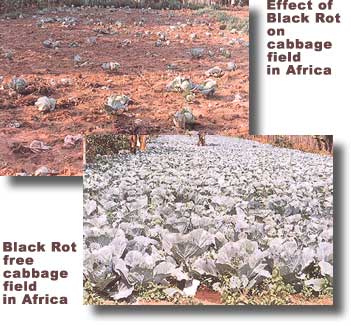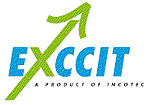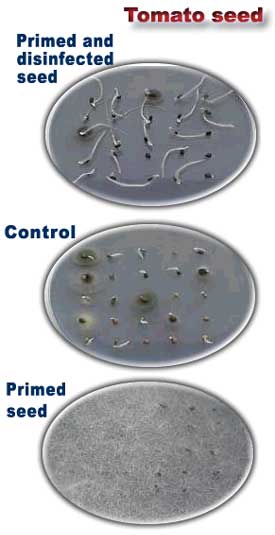It is very important for a
grower to start with high quality, disease-free seed.
Seed production areas that have
endemic populations of the disease organisms and stricter
governmental regulations that limit the use of pesticides are making
the path to this objective a true challenge.
 The
seed industry has responded by developing various seed
technology methods such as mechanical cleaning, disinfection
procedures and specialized coatings in an attempt to eradicate
seedborne microbial organisms and/or pathogens. Disinfection
methods that are in use include treatments with hot water,
calcium hypochlorite,
ozone or UV-C radiation.
The
seed industry has responded by developing various seed
technology methods such as mechanical cleaning, disinfection
procedures and specialized coatings in an attempt to eradicate
seedborne microbial organisms and/or pathogens. Disinfection
methods that are in use include treatments with hot water,
calcium hypochlorite,
ozone or UV-C radiation.
Some of these techniques are
well known and widely used by the seed industry. Unfortunately
they are not always successful in eradicating the targeted
pathogen and all too often they have a negative influence on
seed quality and result in a loss of shelf-life.

INCOTEC
has ongoing research projects,
which are focused on developing methods for the eradication of specific
seedborne pathogens. A result of this research is a product range offered to the
seed industy under the name "eXccit". The main advantage of this
product is that it is effective, while being gentle to the seed. The
resulting seed is free of the pathogen (0 infection in 30,000 seeds, using the best test
methods available). On the other hand the seed germination characteristics
remain equal or are even slightly improved, i.e. faster germination.
eXccit
is a product that combines specific priming and disinfection technologies.
In extensive tests the combination has been fine-tuned to
obtain a treatment that combines the benefits from both
technologies. This combination provides the optimal
conditions for eradicating the targeted pathogens, while using
the priming process to alleviate the putative negative
effects.
eXccit has
first been developed especially
for the eradication of black rot (Xanthomonas campestris pv.
campestris) from almost all Brassica oleracea types. This process
was found to
be remarkably successful, with a 98% success rate on more than a thousand
infected Brassica seedlots.
eXccit has also successfully been used on a
number of other crops infected by Xanthomonas spp.
(see table 1)
|
eXccit products |
Targeted pathogen |
Brassica
|
Xanthomonas campestris
pv. campestris
Xanthomonas campestris pv armoraceae |
|
Carrot |
Xanthomonas
campestris
pv. carotae |
|
Leek |
Pseudomonas syringae pv porii |
|
Pepper |
Xanthomonas
campestris
pv. vesicatoria |
|
Tomato |
Xanthomonas
campestris
pv. vesicatoria
Clavibacter michiganensis
|
|
Seed produced under natural
conditions are not free of micro-organisms and commonly have a microbial
population that includes bacteria, fungi and even some viruses.
Usually this microbial population is made up of non-pathogens, or
relatively harmless microbes. However, even these relatively harmless
organisms can cause problems if their numbers become too high. They
may cause for instance a decrease in germination capacity or loss of
healthy seedlings.
INCOTEC
has long recognized
the need for the control of the microbial population and has developed
procedures to also effectively deal with this problem during the seed
priming process. Although priming is a good tool to enhance the quality of
the seed, during priming microbes can and will increase in numbers if
nothing is done for their control.
Therefore,
INCOTEC has worked to develop priming
methods that have the additional feature of a control over microbial growth. Seed
primed with these new priming methods are not free of micro-organisms, but the microbes remaining
on the seed are kept to small, harmless populations. The result is an even
better response to priming and cleaner seed than before priming.
Table 2
Effect of clean priming of
cucumber seed on germination rate (GE) and capacity (GC), tested
under sub-optimal conditions at 16° C.
Level of bacteria and fungi
expressed in colony forming units per gram seeds.
| |
GE(%) |
GC (%) |
Bact (cfu) |
Fung (cfu) |
|
Untreated |
0 |
82 |
1.8x104 |
3.0x101 |
|
Priming |
89 |
90 |
1.0 x106 |
2.9x104 |
|
Improved clean priming |
93 |
90 |
6.0x102 |
<10 |
|
Table 3
Effect of clean priming of tomato seed on germination and micro-organism level.
Erwinia is an example of a putative problem causing
micro-organism. GE = germination rate, GC =
germination capacity. Bacteria and fungi level is expressed in colony
forming units (cfu) per gram seeds.
| |
GE (%) |
GC (%) |
Bact
(cfu)
|
Fungi (cfu) |
Erwinia |
|
untreated |
47 |
80 |
3.5 x 103 |
5.8 x 102 |
+ |
|
Priming |
86 |
80 |
5 x 105 |
6 x 104 |
++ |
|
Improved clean priming |
71 |
89 |
4 x 101 |
<10 |
- |
|
| |
|
|
Effect
of clean priming
on tomato seedling development

|
Effect
of clean priming on microorganism development on tomato seeds on
nutrient-rich agar

|